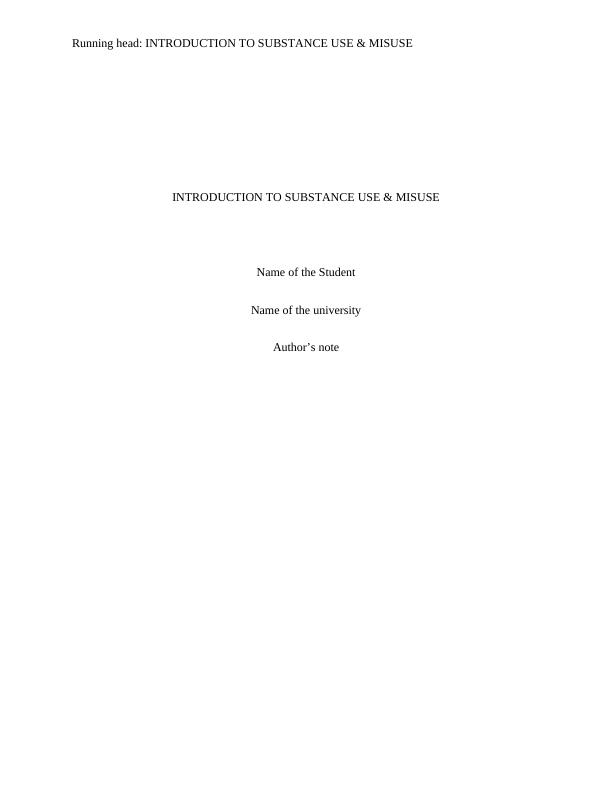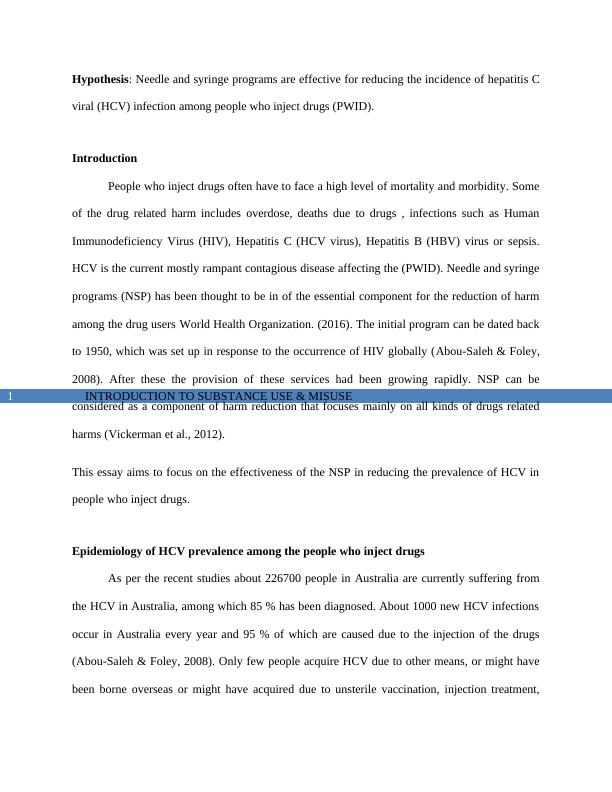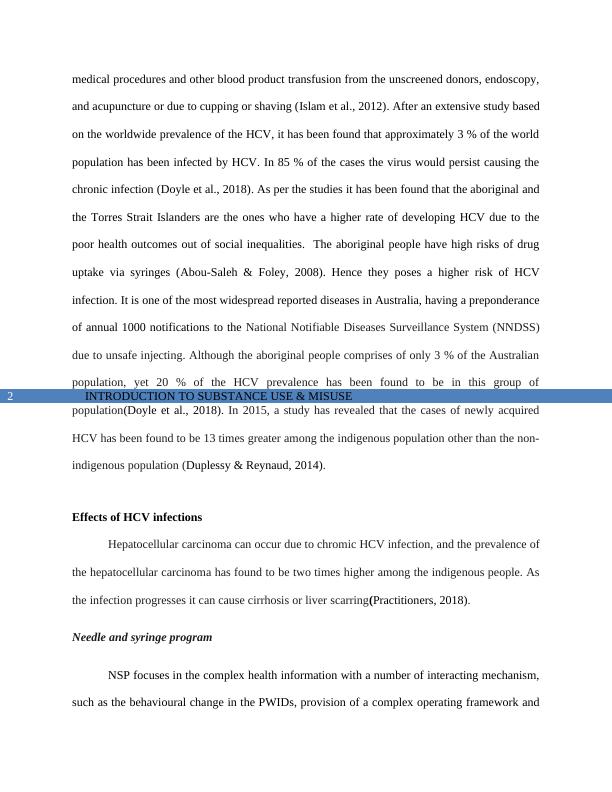Substance Use And Misuse (pdf)
Added on 2021-06-17
17 Pages4982 Words99 Views
Running head: INTRODUCTION TO SUBSTANCE USE & MISUSEINTRODUCTION TO SUBSTANCE USE & MISUSEName of the StudentName of the universityAuthor’s note

INTRODUCTION TO SUBSTANCE USE & MISUSE1Hypothesis: Needle and syringe programs are effective for reducing the incidence of hepatitis Cviral (HCV) infection among people who inject drugs (PWID).IntroductionPeople who inject drugs often have to face a high level of mortality and morbidity. Someof the drug related harm includes overdose, deaths due to drugs , infections such as HumanImmunodeficiency Virus (HIV), Hepatitis C (HCV virus), Hepatitis B (HBV) virus or sepsis.HCV is the current mostly rampant contagious disease affecting the (PWID). Needle and syringeprograms (NSP) has been thought to be in of the essential component for the reduction of harmamong the drug users World Health Organization. (2016). The initial program can be dated backto 1950, which was set up in response to the occurrence of HIV globally (Abou-Saleh & Foley,2008). After these the provision of these services had been growing rapidly. NSP can beconsidered as a component of harm reduction that focuses mainly on all kinds of drugs relatedharms (Vickerman et al., 2012). This essay aims to focus on the effectiveness of the NSP in reducing the prevalence of HCV inpeople who inject drugs.Epidemiology of HCV prevalence among the people who inject drugsAs per the recent studies about 226700 people in Australia are currently suffering fromthe HCV in Australia, among which 85 % has been diagnosed. About 1000 new HCV infectionsoccur in Australia every year and 95 % of which are caused due to the injection of the drugs(Abou-Saleh & Foley, 2008). Only few people acquire HCV due to other means, or might havebeen borne overseas or might have acquired due to unsterile vaccination, injection treatment,

INTRODUCTION TO SUBSTANCE USE & MISUSE2medical procedures and other blood product transfusion from the unscreened donors, endoscopy,and acupuncture or due to cupping or shaving (Islam et al., 2012). After an extensive study basedon the worldwide prevalence of the HCV, it has been found that approximately 3 % of the worldpopulation has been infected by HCV. In 85 % of the cases the virus would persist causing thechronic infection (Doyle et al., 2018). As per the studies it has been found that the aboriginal andthe Torres Strait Islanders are the ones who have a higher rate of developing HCV due to thepoor health outcomes out of social inequalities. The aboriginal people have high risks of druguptake via syringes (Abou-Saleh & Foley, 2008). Hence they poses a higher risk of HCVinfection. It is one of the most widespread reported diseases in Australia, having a preponderanceof annual 1000 notifications to the National Notifiable Diseases Surveillance System (NNDSS)due to unsafe injecting. Although the aboriginal people comprises of only 3 % of the Australianpopulation, yet 20 % of the HCV prevalence has been found to be in this group ofpopulation(Doyle et al., 2018). In 2015, a study has revealed that the cases of newly acquiredHCV has been found to be 13 times greater among the indigenous population other than the non-indigenous population (Duplessy & Reynaud, 2014). Effects of HCV infectionsHepatocellular carcinoma can occur due to chromic HCV infection, and the prevalence ofthe hepatocellular carcinoma has found to be two times higher among the indigenous people. Asthe infection progresses it can cause cirrhosis or liver scarring(Practitioners, 2018).Needle and syringe programNSP focuses in the complex health information with a number of interacting mechanism,such as the behavioural change in the PWIDs, provision of a complex operating framework and

INTRODUCTION TO SUBSTANCE USE & MISUSE3flexibility (Pouget et al., 2016). A number of interventions had been taken in order to reduce thewide ranges of harm in the population such as improving the access and the use of the sterileinjecting equipment (Des Jarlais et al., 2013). These involved numerous processes of deliveryand sale such as the conventional NSP in the fixed sites, dispensing machines, and thedistribution and outreach programs such as campaigning with mobile vans or bus and home visits(Pouget et al., 2016). The pharmacy and the needle exchange program provides with a variety ofinformation regarding reduction of harm("Department of Health | National needle and syringeprograms strategic framework 2010-2014", 2018). NSPs has been supported and endorsed byWHO, UNODC and UNAIDS as an essential public health program for ensuring that the drugusers do not share their own injecting equipment with others and that the circulation time of theused needles are educed and the that the equipment are disposed safely(World HealthOrganization, 2016).The First NSP was trialed in Australia in the year 1986 in New South Walesand mainly occurred following the discovery of the HCV and the potential threats it poses to theAustralian population (Lazarus et al., 2018). Third program is the single most cost efficient and asignificant approach in Australia for mitigating the drug related harms among the Australianpopulation (Fernandes et al., 2011). The NSP service provisionsThe NSP service provisions normally consists of three outlets type-The primary NSPsThe secondary NSPsThe pharmacy NSPs.

End of preview
Want to access all the pages? Upload your documents or become a member.
Related Documents
Social Determinants of Healthlg...
|11
|3164
|277
Health Promotion Grant Application for Prisoners in Western Australialg...
|18
|3752
|149
Introduction to Social Work and Human Services Assignment 2022lg...
|16
|2451
|21
Viral Hepatitis B: Understanding the Disease and the Role of Agencies in Controlling Itlg...
|14
|4322
|449
Using the Principles of Primary Health Care to Protect and Promote Human Immunodeficiencylg...
|8
|2372
|314